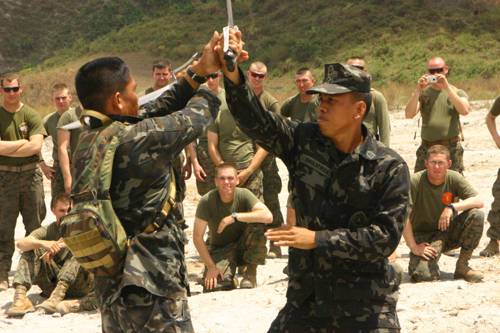
FAQ About The Cultural Influence of Filipino Martial Arts

What is Filipino Martial Arts (FMA)?
Filipino Martial Arts (FMA) refers to a set of martial systems developed in the Philippines. The most popular styles include Arnis, Eskrima, and Kali. These martial arts are known for their focus on weapon-based fighting, particularly with sticks, knives, and bladed weapons, although they also include empty-hand techniques, joint locks, and grappling.

How have Filipino Martial Arts influenced global martial arts?
Filipino Martial Arts have significantly influenced global martial arts, primarily through their integration into military and law enforcement training worldwide. FMA techniques are valued for their practical approach to armed and unarmed combat, swift training methodology, and effectiveness under high-stress situations. Additionally, FMA has been adopted in various combat sports and is prominently showcased in movies and television series, further spreading its influence.

What weapons are commonly used in Filipino Martial Arts?
The most common weapons used in Filipino Martial Arts include sticks (often called bastons), knives, swords (such as the bolo), and other bladed weapons. Training often begins with sticks to safely practice techniques that can later be adapted to bladed weapons. Students also learn to defend against and use improvised weapons, emphasizing adaptability.

Are Filipino Martial Arts included in any military training programs?
Yes, Filipino Martial Arts are included in several military and law enforcement training programs around the world. The practical and adaptable techniques of FMA make it suitable for military applications, teaching soldiers and officers effective hand-to-hand and weapon combat skills. The U.S. military, among others, incorporates FMA techniques in their combatives training.

What is Arnis and how is it practiced?
Arnis, also known as Eskrima or Kali in some regions, is a Filipino martial art focusing on weapon-based fighting with sticks, knives, and bladed weapons. Training often starts with sticks to ensure safety while practicing. Practitioners learn footwork, striking, blocking, and disarming techniques, which can transfer to empty-hand applications.

How do Filipino Martial Arts differ from other martial arts?
Filipino Martial Arts differ from other martial arts primarily through their emphasis on weapon-based training from the onset. While many martial arts teach weapons as an advanced discipline, FMA incorporates them from the beginning. Additionally, FMA focuses on practical self-defense techniques that are adaptable to real-world scenarios, emphasizing adaptability and improvisation.

Has Filipino Martial Arts been featured in popular films?
Yes, Filipino Martial Arts have been featured in numerous popular films. Movies like "The Bourne Identity," "John Wick," and "Dredd" prominently showcase FMA techniques, particularly in close-combat sequences. These films highlight the fluid and effective movements that characterize FMA, contributing to its growing popularity worldwide.

What cultural significance does Filipino Martial Arts hold in the Philippines?
Filipino Martial Arts hold significant cultural importance in the Philippines as they are part of the country's heritage and history. They embody the Filipino spirit of adaptability, resilience, and resourcefulness. FMA is not only a martial discipline but also a way to pass down cultural stories, values, and traditions through structured training and community events.

Can Filipino Martial Arts be practiced by all ages?
Yes, Filipino Martial Arts can be practiced by individuals of all ages. Many schools offer classes tailored to both children and adults, emphasizing fundamental skills, safety, and age-appropriate techniques. The focus on weapon drills aids in improving coordination, discipline, and confidence, making it accessible to a wide demographic.

What is the origin of Filipino martial arts like Eskrima?
Filipino Martial Arts like Eskrima have ancient roots dating back to pre-colonial Philippines. They were used by indigenous tribes for self-defense and warfare. Throughout history, these arts have evolved, blending techniques from various influences, including Spanish, to form what is now modern-day FMA. They served as essential survival skills during colonization and local conflicts.

How does training with weapons in FMA improve self-defense skills?
Training with weapons in Filipino Martial Arts improves self-defense skills by increasing coordination, timing, and awareness. Practitioners learn to anticipate and react swiftly to attacks, utilizing both offensive and defensive techniques. This training enhances empty-hand skills, as many weapon techniques are transferable, teaching effective self-protection strategies even without weapons.

Is Filipino Martial Arts recognized in international martial arts competitions?
Yes, Filipino Martial Arts are recognized in international competitions, notably in events like those organized by the World Eskrima Kali Arnis Federation (WEKAF) and the International Modern Arnis Federation. These competitions showcase traditional and modern aspects of FMA, featuring events such as single-stick, double-stick, and forms (anyo) competitions, gaining global recognition and participation.

How do Filipino Martial Arts promote physical fitness?
Filipino Martial Arts promote physical fitness through rigorous training that improves strength, agility, and endurance. The practices emphasize footwork, coordination, and flexibility, while also increasing cardiovascular fitness. Regular training involves drills, sparring, and other exercises that help practitioners maintain a high level of physical health.

Are there any traditional clothing or gear associated with Filipino Martial Arts?
Traditional clothing associated with Filipino Martial Arts varies by style but often includes comfortable athletic wear and protective gear such as padded sticks, headgear, and hand protectors during sparring. Some practitioners wear uniforms similar to those in other martial arts, often incorporating elements that reflect Philippine culture and heritage, such as specific colors or emblems.

What are some common misconceptions about Filipino Martial Arts?
One common misconception about Filipino Martial Arts is that they are solely weapon-based. While FMA places significant emphasis on weapon training, it also incorporates empty-hand techniques, joint locks, and grappling. Another misconception is that it's too dangerous for beginners, but with proper instruction and safety gear, it is accessible and safe for all levels.

How can someone get started with learning Filipino Martial Arts?
To get started with Filipino Martial Arts, it's advisable to find a reputable dojo or martial arts school that offers FMA classes. Prospective students should look for experienced instructors and programs that focus on safety, proper technique, and cultural understanding. Beginners can start by attending beginner classes or workshops and gradually progress as they build skills and confidence.

What role do community events play in Filipino Martial Arts?
Community events play a significant role in Filipino Martial Arts by fostering camaraderie, cultural exchange, and knowledge sharing among practitioners. Events such as tournaments, seminars, and festivals provide opportunities for practitioners to demonstrate skills, learn from instructors, and engage with the cultural aspects of FMA. These gatherings are crucial for preserving and promoting FMA traditions and fostering a sense of community.

How has Filipino Martial Arts evolved over time?
Filipino Martial Arts have evolved significantly over time, adapting to various social and cultural changes. Initially used for tribal warfare and defense, FMA has integrated aspects from other martial arts and fighting styles due to historical interactions, such as during Spanish colonization. Modern FMA continues to evolve, incorporating new techniques, training methods, and applications, making it relevant to contemporary martial arts enthusiasts.

What is the significance of stick fighting in Filipino Martial Arts?
Stick fighting holds great significance in Filipino Martial Arts as it serves as the foundation for learning other weapons and empty-hand techniques. The use of sticks provides a safe and effective way to practice angles of attack, footwork, and defensive movements. Stick fighting also hones skills that are directly applicable in self-defense situations, and it is an integral aspect of many FMA competitions and demonstrations.

What are some notable schools or instructors of Filipino Martial Arts?
There are several notable schools and instructors in the world of Filipino Martial Arts. Some prominent figures include Remy Presas, founder of Modern Arnis, and Dan Inosanto, a student of Bruce Lee and proponent of Jeet Kune Do who has extensively promoted FMA. These instructors have established schools and systems that continue to teach and advance the practice of Filipino Martial Arts globally.
